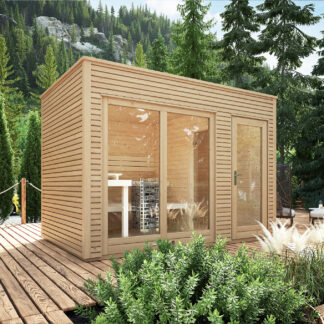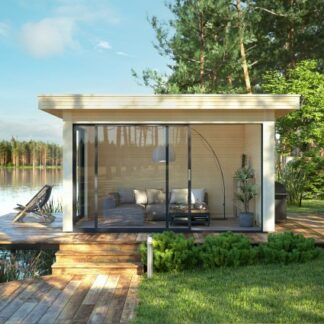
Log Cabin Buyers Guide
There are several things to consider when buying a log cabin:
- Source of timber for your cabin
- Single or double wall
- Weather boards and rain sills
- Quality of interior finish
Where does the timber come from?
The first thing any log cabin buyer will see when purchasing a log cabin is the timber, or lumber. At Timberliving, our log cabins come from the Baltic states, a region with a rich heritage of building solid, cosy log homes. Our log cabin timber is sourced from sustainable reputable forestries located mainly in Finland, Norway and Sweden.
All of our trees are Norway Spruce, and generally referred to as Arctic Spruce, since they are grown in the Artic Circle. Growing in this region creates trees that are extremely durable and of high quality. This is because of the slow growing season – about three or four months a year. This slow growing means the grain of the trees is very tight. This creates extremely tight timber, which won’t warp, twist or split as easily as Irish grown timber.
Log Cabin Walls
Single or double walls? Some cabin companies in Ireland offer single wall cabins for residential living. Unless these walls are at least 200mm (8 inches) thick, you are going to encounter some serious dampness (and ensuing health) issues. So if you’re dealing with a company that is telling you that 75mm or 90mm think single walls are sufficient, walk away!
A double wall if obviously going to make your cabin more expensive, but you will need the extra wall to create a cavity for your insulation.
Our standard cabin walls have a four inch cavity, which we fill with highly insulating METAC insulation, which is like a high density rock woll. You can increase this cavity to six, or even eight inches if you wish.
Weather boards
Weather boards are an important element in the construction of a log cabin. They protect the protruding ends of a log cabin from water/rain ingress, which can lead dampness within a cabin and rotting of cabin corners. These weatherboards are a crucial element for your log cabin, and should always be included.
In fact, its because of the lack of weatherboards on some competitors cabins over the years that has given log cabins such a bad name in Ireland. There have been log cabin companies in Ireland selling single-wall cabins to people as residential units. The wall thickness on these cabins varied between 70 and 95mm thickness, and the ends of the logs were exposed to the elements. This caused all sorts of problems for the residents of these buildings. This is why most planners now insist that log cabins cannot be built without cement board on the cabin exteriors.
Log Cabin Buyers – look closely at the interior
As a log cabin buyer, you might be really keen about the exterior look of a log cabin. And why wouldn’t you be! Most people fall in love with a log cabin when they see one. But the interior details are very important too. You should pay heed to the door and window architraves, the wall skirting and coving, and the details at the roof beam/wall junction.
What about the interior doors? Are the door handles of a sufficiently high quality? Is there a seal on the doors. Are the hinges solid?
Every log cabin buyer should also test the external doors and windows. Open and close the windows and get a feel for the hardware – hinges and locks. Look at the gap in the double glazing – the wider the better.



